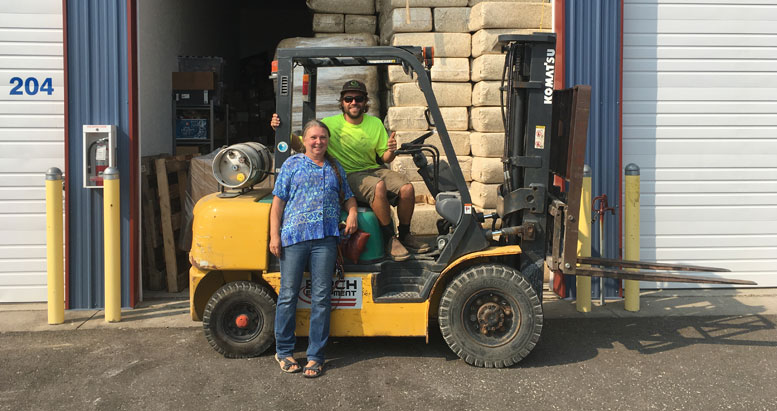Matthew Mead is an entrepreneur and builder, and the founder of U.S.-based Hempitecture, a hemp construction contractor. He studied sustainable building techniques in earning a Bachelor of Architectural Studies degree from Hobart and William Smith Colleges (New York). In 2014, his firm partnered with Idaho Base Camp, an environmental retreat center in the U.S. state of Idaho that brought together a multi-disciplinary team to create a natural building on a grassroots budget. He is currently helping to coordinate a pioneering hemp retrofit construction project with Highland Hemp House (Washington State, USA).
HT: How is the concept of hemp building being received these days – architects, builders, and building supply firms – down to the market level with the potential client base. What’s the general awareness level about hemp construction and its benefits?
MM: In 2013 when I was presenting the earliest concepts of what Hempitecture would become at various entrepreneurial business competitions and expositions, there were zero states that had any sort of pro-hemp amendment. There were under a handful of hemp buildings completed in the U.S. at the time and a majority of the venture capital panels I was presenting to thought I was insane. I’d reach out to architects, structural engineers and building enthusiasts; many thought the idea of using hempcrete as a building material was impossible, outlandish, and perhaps only for those who exist at the nexus of counter-culture and impracticality. This is changing dramatically.
There are well over 20 hempcrete structures in the U.S. now. There are hempcrete workshops appearing all over the country. There are more people who are becoming aware of the need for changing our building strategies. There are more indiviudals who are realizing the potential of hempcrete and want to build their own home or project with it. With that being said, the education campaign necessary to bring awareness to the general public of this construction method is marginal.
“Every hemp building project put in the ground is monumentally important because it highlights the possibility.”
Hemp building, is indeed, a niche interest. Often we hear comparisons of hempcrete to materials like concrete, with hempcrete being a viable alternative to reducing the carbon footprint of the concrete industry. Unfortunately, these comparisons are delusions of scale. Concrete is incorporated in virtually every building project in the world and it has an entirely different set of properties and purposes than does hemp building. It is idealistic yet partially unreasonable to think that in 10 years every building project in the United States will begin to incorporate hempcrete as opposed to other carbon-dioxide intensive materials such as concrete. This is not meant to sound negative.
Every hemp building project put in the ground is monumentally important because it highlights the possibility. It makes the potential more known and it encourages an industry here in the U.S. to emerge and grow with confidence. We cannot support and grow an emerging industrial hemp agronomy without the proper output end-uses understood. For instance, how is a farmer to know that it’s an economically viable option to convert his agricultural processes over to a hemp-producing operation without understanding what his crop will get used for and how much the individual plant constituents will be sold for? Hemp building is an important part of supporting the larger hemp agronomy here in the United States.
With that being said, overall for most people, concepts of hemp building are a new and surprising topic for all players in the building sector, from architects to builders to the clients. At this point, the hemp building industry is still in its infancy and it requires inspired, enlightened, or motivated individuals to embrace the risk that a hemp building project presents. In a society where we have robust licensing, insurance, and business requirements, hemp building exists in this abstract, uninsurable realm of newness. How does one get insured to build a building in a manner that isn’t accepted by our flawed understanding of building science? How does one work as part of a collaborative team where designs, engineering, and subcontracting relationships rely on definitive information, data, and planning, when what you’re planning will inevitably present challenges and new questions?
Hemp building has a long way to go to become a mainstream strategy, moving from niche to conventional. This is what inspires our work, bridging the gap between high quality conventional construction and a forward thinking natural building strategy like hempcrete.
HT: What were your major takeaways from your experience with the Idaho BaseCamp (IBC) project?
MM: You don’t know what you don’t know until you know you don’t know it. I came from an academic background, studying architecture in college and understanding hempcrete from a level that was gained from literature, research, and some hands-on experimentation. I realized that there exists a tremendous gap in the building sector – a disconnect between the office-based professional and the hands-on builder working hammer-and-nail on site. I spent three months working with a collaborative group on the architectural plan and design for the IBC project, yet was also tasked with hands-on building on site. This process, going from studio with pen and scale, to on site with hammer and nail, opened my eyes to the disconnect between the practice of architecture and the implementation of a building.
I knew after this experience that I wanted to exist in between these worlds. I spent three years following the IBC project working for a high-end custom construction company in Idaho to bridge the gap between my architectural understandings and my ability to direct and lead a building project on site. The Highland Hemp House is an opportunity for me to bring my craftsmanship and experience of working through a hemp building project to the table and help create a high quality, well constructed home. I believe hempcrete, to be taken seriously, must be applied in practical, conventional scenarios. Otherwise, hempcrete is certain to remain on the fringes, in a place that is a deep niche, not a solution to the problems our built environment presents.
HT: What led to your passion for hemp as a construction material?
MM: I have always been entrepreneurially motivated. When I was in college I owned an action sports lifestyle based clothing company. It was my passion, however I had a realization one day. I realized that my company had no aspect of doing something greater than purveying cool gear. There was no aspect of giving back, sustainability, or bettering the earth. I knew that I could seek deeper sense of fulfillment. When I was studying architecture I undertook an independent study that I titled “The Contemporary Relevance of Earth Architecture.” I attempted to review many different natural building methods, methods that relied on using earthen materials. In this study I concluded that hemp building presented the most practical opportunity for bringing earthen building strategies to the US.
I knew shortly after concluding my thesis that hemp building would be my life’s work. I want to bring legitimacy to hemp building. I want it to be a respected strategy. I think I have a long way to go to complete that mission and it is my hope that others in the “hemp building sphere” take it as seriously as I do.
HT: What’s the key to getting hemp a seat at the table in the broader “green building” discussion?
MM: There is no single key to hempcrete building strategies becoming taken more seriously in the broader green building discussion. It requires an effort from multiple different aspects, but if I was to say that there is one thing that is particularly of importance, it’s that hemp building projects be taken on in such a manner that legitimizes the industry, not diminishes it.
“I have made it my mission to only pursue hemp building in a light of professionalism, one that has been gained from experience and years of working hands-on in construction.”
I learned this first hand from a discussion with Tom Wooley from University of East Anglia a few years ago. I reached out to him with youthful enthusiasm and no practical building experience about the Idaho BaseCamp project that I was about to take on. Being an international leader in hemp building, I was seeking his input and advice on certain questions after reading his book. He cautioned me that a hemp building project that is done improperly or fails can become an example that detracts from the legitimacy of an emerging practice. It took some years and maturity to realize that perhaps he was urging me to take the endeavor seriously because as a pioneer of hemp building, his body of work and progress made could be hindered by the misinformed enthusiast promoting poor examples of hemp architecture.
I have made it my mission to only pursue hemp building in a light of professionalism, one that has been gained from experience and years of working hands-on in construction. I believe it is important that we innovate how we build and install hempcrete homes for it to become a more widespread strategy. The impact of hemp-based construction can be, and will be, most felt when it can be considered a strategy that is as respectable as conventional construction techniques.
HT: We noticed that your Idaho Base Camp project was successful in reaching its’ goal on Kickstarter. Do you have any insight into keys to a successful crowdfunding campaign?
MM: Planning is the most important part of a crowdfunding campaign. I hate to repeat a common phrase, but it’s true: If you fail to plan, plan to fail. Spend 3-6 months planning your crowdfunding campaign. Every component of your campaign must be well assembled for it to be a success.


